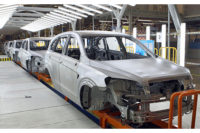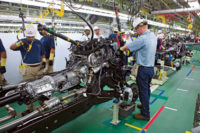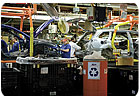
Subaru of Indiana Automotive (SIA) Inc.’s green manufacturing success is not a rags to riches story. Rather, it’s a riches in rags story-literally.
Workers in the paint shop at the Lafayette, IN, plant collect solvent-soaked polyester rags that are then treated onsite every couple months by a recycling company. The rags are centrifuged and the solvent reclaimed.
Because the rags can’t be tossed in the trash, the recycling company has found another use for them. The recycling company breaks the rags down to their original polyester state and extrudes this material into covers for wiring harnesses. These covers are sold to various automakers, including Ford and Chrysler, who use them for harnesses installed beneath vehicle floor boards.
Innovative ways to reuse and recycle all materials in the plant has been standard practice for SIA since 2002, when it set out to became the first zero landfill auto plant in the United States. The company achieved its goal in 2004, but it wasn’t long before many other automakers followed SIA’s example.
General Motors’ Flint (MI) Engine South manufacturing plant became zero landfill in 2005. A few years later, the automaker set a goal that half of its 145 manufacturing plants worldwide would be zero landfill by the end of 2010. The company announced last December that 76 plants were zero landfill, surpassing its goal.
Other automakers, like BMW MC in Greer, SC, are on the path to becoming zero landfill. BMW hopes to make its assembly technology facility in the plant zero landfill by the end of 2012-and eventually do the same for the plant’s body and paint shops.
All of these companies are committed to zero landfill as part of their green manufacturing practices. However, their paths to success are unique.
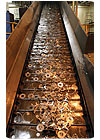
Last year, all General Motors manufacturing plants recycled or reused 2.5 million tons of waste, including 1.8 million tons of scrap metal. Photo courtesy General Motors
Much More Than Recycling
The SIA plant was destined to be “green” even before it opened in 1989. This is because the property on which the plant was being built contained about 200 acres of wildlife habitats-and joint partners Subaru and Isuzu decided to keep the habitats intact. The habitats remain and are home to coyotes, beavers, geese, owls, herons, white tail deer, hawks and bald eagles.Fourteen versions of the Subaru Outback, Legacy and Tribeca are made at the SIA plant, as well as the Toyota Camry LXE. This plant is the lone U.S. manufacturing facility operated by Subaru. It features more than 3.4 million square feet of floor space and employs 3,650 people. About 85 percent work in production, including 650 production associates hired since May 2009.
SIA has recovered well from the auto industry’s deep recession of 2008-09 and is producing more cars than ever. For the fiscal year ended March 31, 2011, the plant produced 254,000 vehicles, although the number could have been higher had the earthquake and tsunami in Japan not hindered the availability of parts.
“The vehicles we produce must be good for the environment,” says Tom Easterday, executive vice president for SIA. “And, green manufacturing can produce dividends that are also good for business.”
The start of SIA’s green manufacturing program can be traced to Subaru’s corporate belief in kaizen, or continuous improvement. One tenet of kaizen is reducing waste, which is often a drag on production.
“Waste is money and thus, unnecessary spending,” says Denise Coogan, manager of safety and environmental compliance. “Some waste is minimal and some is significant, but it all adds up.”
Coogan says that the plant began a basic can and bottle recycling program in 2000. Then, in 2002, the plant’s green manufacturing program shifted into high gear when parent company Fuji Heavy Industries challenged SIA managers to reduce the amount of waste being sent to the local landfill to zero by 2006.
Managers held ‘Dumpster diving’ exercises to show employees how much waste was being generated and how much could be reused, recycled or composted. Employees were asked for input on ways to implement the three Rs and help the company become zero landfill. Many suggestions are regularly received and frequently implemented.
Next, waste streams were identified in all areas of the plant and material-reduction programs implemented. Data analysis indicated that unused steel in the stamping area accounted for the most waste. Coogan says that, in 2000, each vehicle generated 459 pounds of waste-with steel accounting for nearly 75 percent of it.
In the past nine years, SIA has reduced the amount of steel used in each vehicle to 190 pounds, a reduction of 102 pounds, or 65 percent. Overall waste per vehicle has declined by 46 percent to 241 pounds per vehicle, saving SIA several million dollars per year.
Packaging waste was another problem, and SIA tackled it using a two-fold approach. First, it reduced the size and weight of all packaging materials. Second, the company began reusing Styrofoam packaging used to ship transmissions and engines back and forth to Japan up to 10 times. This latter practice saves SIA about $1.3 million annually.
On both assembly trim lines, pallets are reused several times and then recycled. In 2010, SIA reused 995 tons of such pallets.
Other items reused include brass washers and protective plastic caps, which are sent back to suppliers. Coogan says more than 700,000 caps were collected and reused last year.
As for recycling, multiple programs were implemented, and have been maintained, throughout the plant. One is for all employees to collect all reusable and recyclable items, regardless of size. These include the stems of tiny blind rivets, which are used in assembly.
In the body and metal finishing shops, welding slag shavings are swept up and collected in barrel drums. The shavings are recycled so metals like copper and zinc can be reclaimed.
Also, the copper tips on the robotic welders used in the body and metal finishing shops are sharpened rather than discarded. “The workers there made a pencil-sharpener-like device to do this,” says Coogan.
Energy conservation and reducing the plant’s carbon footprint are also part of SIA’s green manufacturing program. On a per-vehicle basis over the past 11 years, SIA has cut electricity by 21 percent, CO2 emissions by 27 percent and VOCs by 41 percent.
Although no waste generated at the plant goes to the landfill, about 4 percent consists of items that can no longer be reused (like certain packaging) or can’t be composted or recycled (like restroom trash). This waste is incinerated by Covanta Energy at its Indianapolis energy-from-waste facility. The resultant ash is used for road surfacing.
“Focus on reduction, reuse and recycling, in that order,” says Coogan. “Make it as easy as possible for associates to offer ideas and follow the three Rs. And give them the tools to do it well.”
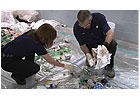
‘Dumpster diving’ exercises show employees how much waste is being generated and how much can be reused, recycled and or composted. Photo courtesy BMW MC
So Many Facilities, One Goal
One of the world’s largest automakers, with more than 200,000 employees in 120 countries, General Motors has continually increased its commitment to green manufacturing since 1995. Flint (MI) Engine South became GM’s first zero landfill manufacturing plant on March 17, 2005.In 2006, GM implemented a by-products program for its manufacturing plants. The program emphasized the need for employees to see waste as ‘a resource out of place.’ It also promoted material reduction, reuse and recycling as a means to reduce waste, increase plant efficiency and improve product quality.
Two years later, in 2008, the company set a goal that half of its 145 manufacturing plants worldwide would be zero landfill by the end of 2010. GM surpassed this goal, with 76 plants becoming zero landfill: 29 in North America and 47 in Europe, Asia and South America.
The company also has seen 10 of its 64 nonmanufacturing facilities (NMFs) worldwide become zero landfill since Sept. 2010. The company has 34 NMFs in the U.S., and five are zero landfill. GM wants another 10 NMFs to become zero landfill by the end of 2011.
“We consider everything that leaves our plant as waste, as a by-product generated by daily production,” says John Bradburn, staff environmental engineer for GM. “That includes scrap, which some manufacturers consider a different category.”
Last year, all GM facilities combined recycled 92 percent of the waste they generated. The company’s manufacturing plants recycled or reused 2.5 million tons of waste, including 1.8 million tons of scrap metal; 126,580 tons of wood; and 80,760 tons of cardboard.
Between 2000 and 2010, GM reduced total nonrecycled waste at manufacturing plants worldwide by 75 percent. During the last five years, it reduced nonrecycled waste by 44 percent globally and per-vehicle-produced waste by 43 percent. On average, more than 97 percent of waste materials from the zero-landfill plants are recycled or reused. The remaining 3 percent is converted to energy at waste-to-energy facilities.
Water use also has been reduced significantly since 2005. Today, GM uses 35 percent less water for manufacturing overall, and 32 percent less per vehicle produced.
Waste-reduction is an ongoing process at GM plants, including zero-landfill ones. Each plant provides a monthly report with data that indicates if waste-reduction goals are being met. The report includes the types and amounts of materials being generated, reused and recycled, along with suggestions on areas that need improvement.
One such area is innovative recycling, which includes the following examples:
Sound-absorber material for the Buick Lacrosse and Verano headliner is made of recycled cardboard shipping materials from various GM assembly plants.
Radiator shrouds for Chevrolet Silverado and GMC Sierra pickup trucks are made from shipping items and plastic caps from the Fort Wayne plant.
Air and water baffles in various GM vehicles contain shreds of tires used for performance testing at the Milford Proving Ground.
Plastic shipping containers durable enough to hold Chevrolet Volt and Cruze engine components have been made from paint sludge from the Lansing Grand River plant.
Another example of innovative recycling was done by GM’s environmental engineers in the spring of 2010 when they collected extensive amounts of used oil booms from BP during its clean-up of the Gulf oil spill. The engineers had a local recycler centrifuge, process and compress the boom into a resin that GM uses in its radiator baffles.
GM’s various recycling initiatives have generated more than $2.5 billion in revenue since 2007. Equally important, says Bradburn, is that GM’s employees and management are more enthusiastic than ever about green manufacturing. They consider it a great opportunity to make sure all GM facilities become and stay zero landfill.
“Our corporate responsibility to the environment remains the main incentive to be zero landfill,” says Bradburn. “We know the importance of doing our part as a member of the global community.”
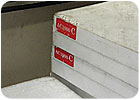
SIA reuses Styrofoam packaging up to 10 times, such as that used to ship transmissions and engines back and forth between Japan. Photo courtesy Subaru of Indiana Automotive Inc.
Small Steps to Success
Slowly but surely, employees at BMW’s Greer, SC, plant are making its assembly technology facility zero landfill. BMW has a goal of reaching zero landfill by the end of 2012.Opened in 1994, the Greer plant is BMW’s only U.S. production facility and builds the Sports Activity Vehicles for world demand. It consists of assembly technology, body and paint facilities, and employs about 7,000 people. BMW manufactures several variants of the X3, X5 and X6 models here, including the X3 and X5 sports activity vehicles, X6 sports activity coupe, X5 and X6 motorsport, and Active Hybrid X6.
Paper, glass and aluminum recycling have always been standard practice at BMW, but the company’s journey to zero landfill really began in late 2009. At that time and early in 2010, BMW representatives attended zero landfill workshops hosted by the Green Manufacturer Network.
Inspired by other manufacturers’ success stories presented at the workshops, BMW initiated its own landfill reduction program in May 2010. The program includes ‘Dumpster diving’ events and extensive employee recycling education and training implemented using Lean Six Sigma methodology. In addition, BMW works closely with suppliers to reduce and or reuse materials wherever possible.
All of these activities helped the plant reduce per-vehicle landfill waste from about 9 kilograms (20 pounds) in 2009 to about 8 kilograms (17.5 pounds) currently. Reusing shipping containers has reduced packaging waste by an average of 67 pounds per vehicle, and waste reduction is continuing.
This past January, BMW created a Green Team with representatives from all areas of the assembly facility. In June 2011, the company announced it wanted the assembly facility to be zero waste by December 2012-and that the first step to reach that goal was to have one third of the 35 areas within the assembly facility be zero landfill by the end of 2011.
Identifying an assembly facility area as zero landfill is a three-step process, says Lisa Pirwitz, section manager in physical logistics for BMW. First, waste champions are identified and a kick-off is held. Waste champions are production associates who promote recycling awareness and look for environmental improvements in their teams. The kick-off involves the waste champion explaining the Zero Waste to Landfill effort to the team and walking the team through the steps necessary to achieve it.
Second, the waste generated in the area is sorted and categorized during both the morning and night shifts. Third, the area earns zero landfill status through auditing by BMW’s waste management provider.
The audit involves daily visits by the waste management company. If all waste in the collection containers in an area are sorted properly during each visit, a green dot is placed on the sheet hanging from each container. After 10 clean audits, the area receives a tentative certificate for zero landfill. Team members must sustain this level of recycling for 6 months before it officially becomes zero landfill.
As of press time, 86 percent of all waste generated at the BMW plant is recycled. The remaining 14 percent is nonrecyclable and going to landfill. The target is to increase recycling and eliminate the remainder with an extended waste-to-energy program. Waste water treatment sludge is the largest single contributor to nonrecyclable waste.
Innovative recycling throughout the plant also is encouraged. For example, paint-shop rags containing excess PVC from seam sealer and underbody spray processes are sent to a nearby Leigh Fibers textile plant for industrial waste recycling. At the plant, the rags are shredded and used to make the insulation padding for the vehicle’s interior. BMW saves nearly $60,000 annually from this practice.
The plant also has a composting program. Café waste is composted on site and used in campus landscaping. This removes about 400 pounds of waste from the landfill each week.
Pirwitz says BMW knows that eliminating landfill has a positive impact on the local community. She says it encourages and inspires associates and local businesses to recycle their waste.
“To achieve zero landfill, you need to have a high-level champion within the company,” says Pirwitz. “You also need to eat an elephant one bite at a time.”

